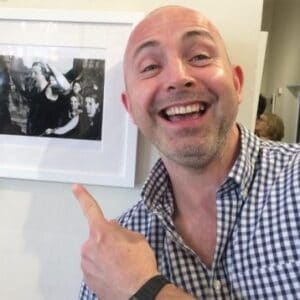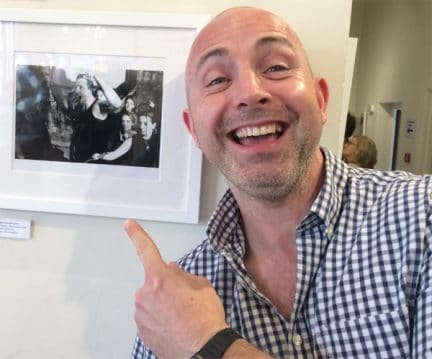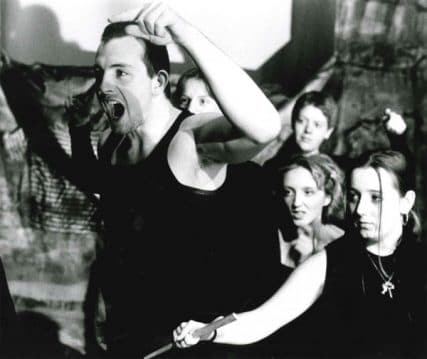Next article:
Big Half – they did it!
Box Office
Social
Address
Half Moon Theatre
43 White Horse Road
London E1 0ND
Registration
If you are contacting us to add your child to the Youth Theatre waiting list, please use the online registration form.
Blog

James attended Half Moon in his teens as a participant and also worked at the theatre early in his career; his daughter now attends our Youth Theatre. In this blog, James talks about his time at Half Moon and also about the importance of our work to offer young people vital access to the arts that may not otherwise exist. James Wakefield is running the Vitality Big Half this Sunday, 1 March, to raise money for Half Moon as part of a team of five runners.

I remember the first session; it was well attended. We completed warm-up name game exercises, then moved into improvisation techniques like the accepting circle. I heard the word tableau for the first time. It was all adrenaline inducing, having to react and respond in quick succession and totally addictive. Around this period, my interests were pricked by method acting and I religiously carried around a copy of Stanislavski’s – An Actor Prepares and was fascinated by actor’s like James Dean and Paul Newman. At school, my difficulty concentrating was seen as problematic and I never took to the banking-based classroom learning. Attending the Half Moon allowed me to express myself differently, to be more creative. It was strange to receive positive feedback from facilitators and colleagues. This enhanced my sense of self and offered a secure base to explore new things.I first attended the Half Moon Young People’s Theatre in 1998 at the tender age of 17 years old. I had just started a performing arts BTEC National Diploma at Dagenham College and was invited to attend one evening midweek by another student on the course. Arriving at the theatre, I was surprised that it was only a ten-minute walk from my front door. It had never entered my awareness; outside the scope of places a young working-class person expected to see in Tower Hamlets. It was interesting to learn at university later on about cognitive biases and schema’s that focus our attention. My interaction with the arts was limited, apart from the occasional theatre in education group at school to warn about the dangers of drugs. Therefore, the possibility of a theatre to attend was outside my schema of what to expect in a community.
I remember the first session; it was well attended. We completed warm-up name game exercises, then moved into improvisation techniques like the accepting circle. I heard the word tableau for the first time. It was all adrenaline inducing, having to react and respond in quick succession and totally addictive. Around this period, my interests were pricked by method acting and I religiously carried around a copy of Stanislavski’s – An Actor Prepares and was fascinated by actors like James Dean and Paul Newman. At school, my difficulty concentrating was seen as problematic and I never took to the banking-based classroom learning. Attending the Half Moon allowed me to express myself differently, to be more creative. It was strange to receive positive feedback from facilitators and colleagues. This enhanced my sense of self and offered a secure base to explore new things.
It was exciting times, to have new pathways opened-up that facilitated my growing curiosities, and to be surrounded by others who shared in this. My participation in the arts linked me to social networks outside existing relationships. It facilitated bridging to others from diverse ethnicities and social-economic backgrounds. It was a great melting pot. This allowed me to visualise how to chart my path, or to realise that mapping my ambitions was possible. On reflection, Half Moon was a space that helped repair my relationship with learning, to link with people from diverse backgrounds and build relationships through common values and interests that sustain until this day.
Half Moon places great value on social participation and inclusion. It works with young people across East London in nurseries, schools, colleges and community and youth organisations. Take the flagship Careers in Theatre programme, a hands-on, project-management style experience of all aspects of professional theatre at KS3/4, offering participants the opportunity to work alongside theatre specialists culminating in creating a performance piece over just one day. Through such programmes, Half Moon uses drama to enable lives. To offer opportunities that are limited in Tower Hamlets.
Half Moon strives to remove barriers that prevent people from fully participating in political, economic, and social life. This is so important in areas like Tower Hamlets, where 56.7% of children live in poverty (after housing costs) according to End Child Poverty (1). It remains a borough of extremes, evidenced by the fact that it has a much higher proportion of both low earners and high earners than the rest of London. This is noted in the Local Economic Assessment (2):
“The very wealthy and the very poor predominate in Tower Hamlets, with little bridging them economically or socially. At its worst, this represents a kind of bi-polar world in which two distinct groups are separated as much by psychological or cultural space as by physical or spatial barriers.”

In such a ‘bi-polar’ community, families who struggle to provide the most basic of needs such as nutrition, clothing, comfortable accommodation will be least likely to invest in social activities and the arts. Investment in trips to the museum, library or theatre will inevitably take a back seat, not out of choice, but out of necessity. Time is limited, as are finances. Therefore, the importance of social infrastructure and gathering places like Half Moon, where the opportunity to engage locally in the arts is so imperative to excluded young people. Social infrastructure provides the setting and context for social participation (3) and such safe havens are essential not only for a neighbourhood’s vitality but also for buffering all kinds of personal problems – mental health issues and gang violence.
Half Moon has invested in many young people over the years, including myself. As suggested, attending the theatre workshops increased my self-esteem. But fundamentally, I think the scaffolding offered during my transition into adulthood facilitated hopefulness and a vision of what is possible. Firstly, Half Moon employed me to work Front of House. Interfacing with many wonderful young people ignited a curiosity to work at an interpersonal level with people. This then led in the early 2000s to training as a workshop facilitator where I was struck by the creativity and imagination of young people. I found doing outreach workshops with toddlers and their parents, diverse in character, at Sure Start Centres in Tower Hamlets riveting. Today, I can proudly claim to be a Trustee at the Half Moon. I have managed to successfully complete two degrees; and enjoy practicing social work in mental health. If I had not gathered at the Half Moon back in 1998, I hold doubt about such pathways of opportunity opening up for me.
Places like Half Moon are an invaluable space for any young person trying to get a hold on their future in a world where division and exclusion abound. It was for me.
References:
Join our mailing list
Don't miss out on the latest shows, news and events updates from Half Moon - sign up to our newsletter.
Support Us
Help us to deliver our vital programme of work and enable us to help young people achieve their potential through the power of the arts.